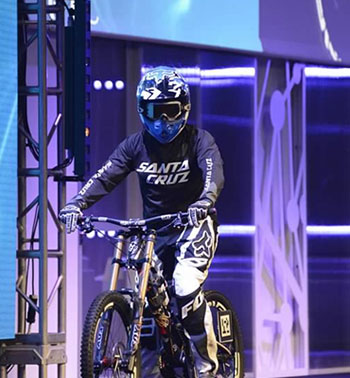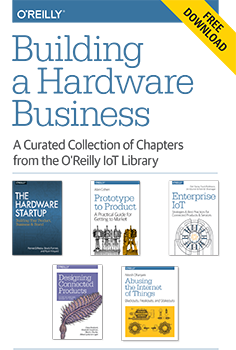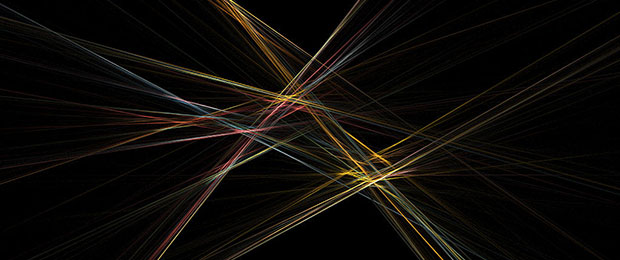"Interaction Design and Connected Devices" entries

Signals from the O’Reilly 2015 Solid Conference
Insight and analysis on the Internet of Things and the new hardware movement.
Practitioners, entrepreneurs, academics, and analysts came together in San Francisco this week to discuss the Internet of Things and the new hardware movement at the O’Reilly 2015 Solid Conference. Below we’ve assembled notable keynotes and interviews from the event.
Lock in, lock out: DRM in the real world
Author and activist Cory Doctorow uses his Solid keynote to passionately explain how computers are already entwined in our lives and our bodies, which means laws that support lock-in are much more than inconveniences. Doctorow also discusses Apollo 1201, a project from the Electronic Frontier Foundation that aims to eradicate digital rights management (DRM).

Driven by the Internet of Things: A mountain bike with a voice
Listening to things in the IoT will redefine manufacturing.

Image courtesy of PTC.
Previously, manufacturers relied on customer feedback to maintain and upgrade products; now, product analytics can fix issues before they happen — and create new opportunities for product design and service. This is done by listening to the “voice of the product or data,” where manufacturers can gather, interpret, and feed product data back into the design cycle, enabling a new set of capabilities that builds value for manufacturers and customers, all driven by the IoT.
Imagine listening to the “voice” of a Santa Cruz mountain bike. The bike, pictured above at the opening of the Boston-based IoT event LiveWorx, demonstrates how physical products can be dissected to their digital cores and this knowledge used to predict and resolve problems. The bike, fitted with sensors and a Raspberry Pi computer for connectivity, tracked wheel speed, suspension pressure, and angle of the steering wheel — all of which was connected to the cloud using our ThingWorx IoT platform. As it was ridden around the stage, its motions were displayed inside a computer-aided design (CAD) model. Combining the power of CAD and product lifecycle management (PLM) with our IoT platform, we merged the bike’s real-world physical interactions into the digital world, creating a “digital twin,” an exact digital representation of the physical bike. Read more…

The IoT will be as fundamental as the Internet itself
Time, technology, and adoption are creating IoT momentum.
Download a free copy of “Building a Hardware Business,” a curated collection of chapters from our IoT library. Editor’s note: this post is an excerpt from “Enterprise IoT: Strategies and Best Practices for Connected Products and Services,” by Dirk Slama, Frank Puhlmann, Jim Morrish, and Rishi M. Bhatnagar, which is included in the curated collection.
If you did a Google search for “IoT” in 2012, the top results would have included “Illuminates of Thanateros” and “International Oceanic Travel Organization.” A search for “Internet of Things” would have produced a results page with a list of academic papers at the top, but with no advertisements — a strong indicator, if ever there was one, that in 2012, few people spent marketing dollars on the IoT. Two years on, and this had changed dramatically. In 2014, the IoT was one of the most hyped buzzwords in the IT industry. IT analysts everywhere tried to outdo each other’s growth projections for 2020, from Cisco’s 50 billion connected devices to Gartner’s economic value add of $1.9 trillion.Until we have reached this point in the future, no one can tell just how realistic these predictions are. However, the excitement generated around these growth numbers is significant, not least because it highlights a general industry trend, while also creating a self-fulfilling prophecy of sorts. We saw something similar happening with the auctioning of new mobile spectrum in the early 2000s. Literally billions were invested in the mobile Internet. And although it took longer than expected (remember the WAP protocol?), the mobile Internet eventually took off with the launch of Apple’s iPhone, and has since exceeded market expectations.
Meanwhile, Google — another major player in the mobile Internet sphere — has bet heavily on the IoT with its acquisition of Nest and Nest’s subsequent acquisition of DropCam. 2014 also saw many large IT vendors, such as PTC with its acquisitions of ThingWorx and Axeda, pushing themselves into pole position in the race for IoT supremacy. On the industry side of things, many central European manufacturers and engineering companies rallied around the Industry 4.0 initiative, which promotes the use of IoT concepts in manufacturing. GE heavily promoted the Industrial Internet and spearheaded the establishment of the Industrial Internet Consortium. Many industrial companies began implementing IT strategies and launching IoT pilot programs. And slowly, the first real results emerged. Read more…

Beacosystem evolution, hurdles, and resources
A look at the issues and trends in deploying beacon-based solutions.
In this post, the third of our series, I’ll look at some of the issues in using and deploying beacon-based solutions, some of the trends in both hardware and software offerings, and share some resources where you can find more detail on everything I’ve covered so far.
First off, let’s take a look at some of the topics that can cause issues, or trip us up when starting to consider a new iBeacon-based solution. In no particular order, these include:
Notifications, Notifications, Notifications
I have many conversations with potential clients that go something like this (in condensed form):
Client: “We want to do a beacon project”
Me: “Great, what are you thinking of?”
Client: “We want to trigger messages to people as they come past or in to our place on their phones”
Me: “OK, is this iOS only?”
Client: “No – of course not – in fact, most of our users are on Android”
Me: “Ah – ok… well…”
(long conversation follows)
With the initial hype and excitement around iBeacon, it’s understandable that there’s some confusion around what’s possible, and what’s not, across all the mobile handsets available today. For now, I’ll focus on just iOS and Android, though we could usefully expand to include Windows and Blackberry. Read more…

Why the Internet of Things isn’t the same as the new hardware movement
Cheap, accessible, open hardware is driving the IoT.
![]()
The Internet of Things (IoT) has been committing a lot of buzzword imperialism lately. It’s a hot term, marching across the technological countryside and looking for rich disciplines to capture. Electronics, manufacturing, and robotics, among others, have all become dominions of the IoT. The result is that the meaning of IoT has broadened to include practically anything that involves 1. technology, and 2. something physical.
At the same time, practitioners have been trying to escape the IoT — and its early association with Internet-connected refrigerators — for years. Big enterprises that want to develop serious applications for the Internet of Things have come up with other terms for what they’re doing, like Internet of Everything (Cisco) and Industrial Internet (GE).
Let’s put a stop to this and define some boundaries. In my view, the Internet of Things is the result of a much larger and more important movement that’s about making the physical environment accessible in the same way that the Internet has become accessible over the last 20 years. I’ll call this the “new hardware movement.” Read more…

The Internet of Living Things
The Internet of Things offers new opportunities in wellness management for businesses and communities.
Register for the free webcast, “Life Streams, Walled Gardens, and the Internet of Living Things.” Brigitte Piniewski and Hagen Finley will discuss the Internet of Living Things, what makes sensoring and monitoring data emanating from our bodies unique, and why we should elect to participate in this seemingly Orwellian mistake of open-sourcing our personal health data.
The majority of the 3.8 trillion dollars spent on sick care today is spent on treating chronic ailments that took decades to become symptomatic.
Making better day-to-day health decisions is by far the least costly way to avoid spending trillions on late-life care. Further, much of people’s health-related suffering can be significantly reduced or eliminated by making better lifestyle choices earlier in life. The business value is clear, but will wearables deliver on the promise to better inform and influence our health decisions?
The IoT model
Network-connected industrial devices have increasingly captured the imaginations of technologists and manufacturers. Real-time reporting from embedded sensors not only changes the way machines function, it changes the way they are sold and operated. GE, for example, rents its jet engines to carriers, then extends that product offering by wrapping the engines with a full-service contract. Sensors embedded in the engines provide consumption-based billing information and allow GE to perform just-in-time maintenance on field-replaceable engine parts. The carrier’s maintenance model is dramatically more effective and efficient than the previous non-sensored model, which either pulled engines out of service based on mileage or based on part failure, both of which translated to waste for the carriers. Read more…

Protecting health through open data management principles
Personal wellness data should be shared as freely as water and air.
Register for the free webcast, “Life Streams, Walled Gardens, and the Internet of Living Things.” Brigitte Piniewski and Hagen Finley will discuss the Internet of Living Things, what makes sensoring and monitoring data emanating from our bodies unique, and why we should elect to participate in this seemingly Orwellian mistake of open-sourcing our personal health data.
We are at a threshold in the history of personal data. Sensors and apps are making it possible to generate digital data signatures of important aspects of healthy living, such as movement, nutrition, and sleep. However, we are rapidly losing the opportunity to erect a Linux-like open “living-well” data system steeped in open commons principles. We can either join together to ensure enlightened open source and crowdsourced discovery practices become the norm for our living-well data footprints, or we can passively allow this data to be sequestered into one of the walled gardens offered by health systems, funded research, or big business.
Why this is important?
Living-well data provides the map by which vast amounts of preventable human suffering can be prevented. Everyone can benefit from the health journeys of those who lived before us because our modern societies are no longer “accidentally well.” Decades ago, parents had no need to question the nutrition a child was offered or concern themselves with how much activity a child engaged in. No deliberate use of devices was needed to track these important health contributors. Reasonable access to whole foods (farm foods) and reasonable amounts of activity were provided, as it were, by default — in other words, by accident. This resulted in remarkably low rates of chronic disease. Today, communities cannot take those healthy choices for granted — we are no longer accidentally well. Read more…

The state of augmented reality
A look at AR today and how we need to design it for tomorrow.
Attend O’Reilly’s Solid Conference, June 23–25, in San Francisco. Solid is our conference exploring how the collision of software and hardware is fueling the creation of a software-enhanced, networked physical world. Helen Papagiannis will speak at Solid on June 24.
Unlike virtual reality (VR), augmented reality (AR) provides a gateway to a new dimension without the need to leave our physical world behind. We still see the real world around us in AR, whereas in VR, the real world is completely blocked out and replaced by a new world that immerses the user in a computer generated environment.AR today
The most common definition of AR to date is a digital overlay on top of the real world, consisting of computer graphics, text, video, and audio, which is interactive in real time. This is experienced through a smartphone, tablet, computer, or AR eyewear equipped with software and a camera. Examples of AR today include the translation of signs or menus into the language of your choice, pointing at and identifying stars and planets in the night sky, and delving deeper into a museum exhibit with an interactive AR guide. AR presents the opportunity to better understand and experience our world in unprecedented ways.
AR is rapidly gaining momentum (and extreme amounts of funding) with great advances and opportunities in science, design, and business. It is not often that a whole new communications medium is introduced to the world. AR will have a profound effect on the way we live, work, and play. Now is the time to imagine, design, and build our virtual future. Read more…

What today’s fitness technology means for tomorrow’s office
How the IoT could help organizations create a better employee experience.
Contributing Author: Claire Niech
Attend O’Reilly’s Solid Conference, June 23–25, in San Francisco. Solid is our conference exploring how the collision of software and hardware is fueling the creation of a software-enhanced, networked physical world.
At 5:37 a.m., Nina’s alarm softly begins to buzz and glow. It has calculated her recovery time based on her previous day’s workout and monitored her sleep tracker to identify the best point in her REM cycle to wake her up. After rising, she grabs a healthy breakfast and her PrepPad or Drop connected kitchen scale records the fat, protein, calories, and carbohydrates in her meal.
For athletes like Nina, this kind of technology-enabled tracking is now standard. When Nina hits the gym for her daily routine, she warms up on a treadmill equipped with sensors to help gauge when she is striking at her optimal force. As she practices technique and form, a ‘smart’ surface records the location and duration of each move. Her training regimen is personalized based on this data; ‘instead of working off a generalized idea of what an athlete needs to be successful, [data analysis] has identified the specific abilities that a player requires to excel in a given sport.’ (From Faster, Higher, Stronger, by Mark McClusky)
Professional athletes today increasingly rely on Internet-connected devices and sensors to boost performance. Yet, the potential of such devices — commonly called the “Internet of Things” — extends beyond sports and fitness; as “weekend warriors” begin to bring these technologies mainstream, it is not hard to imagine that similar devices may soon also help us better understand other complex personal pursuits, such as creativity and productivity at work. As Laszlo Bock, who runs Google’s People Operations, notes: “We all have our opinions and case studies, but there is precious little scientific certainty around how to build great work environments, cultivate high-performing teams, maximize productivity, or enhance happiness.”
Today, many organizations tackle these questions with an industrial-organizational approach, diagnosing the issues most relevant to their workforce using tools such as annual surveys and benchmarking. But today’s approach seldom offers insight on “what works” — ways to track, teach, or reinforce new behaviors, or to see if specific initiatives are achieving the desired effect. Solutions to complex challenges like productivity or satisfaction often vary by organization, and demand better, real-time measurement and testing to enable experimentation.
By weaving together our physical and digital environments, sensors could help organizations analyze how factors like mood, focus, social engagement, or movement contribute to the employee experience — and even help replicate or enhance this experience. Consider how this new technology could impact how companies do work, assess outcomes, and enable employees to thrive. Read more…

Google’s Physical Web vs Apple’s iBeacon
How proximity approaches compare and a look at the flourishing proximity startup ecosystem.
Editor’s note: This is the second post in a series looking at beacon technology and the burgeoning beacon ecosystem.
In the first of this series, I covered some of the basics behind proximity, Bluetooth Low Energy, and iBeacon, and walked through some use cases where proximity and iBeacon have started showing up in retail, travel, and other applications.
While iBeacon has arguably galvanised the notion of using proximity in applications and services, it’s not the only game in town.
In this post, I’ll cover one of the alternatives to Apple’s iBeacon, Physical Web from Google, and then I’ll zoom out to look at the flurry of activity in startups in the evolving “Beacosystem.”
First, a small recap on what helped iBeacon gain so much traction, so quickly and helped shape the landscape for a proximity ecosystem to emerge.
Creating an ecosystem
Apple’s iBeacon is a layer, or a “convention,” that builds on the Bluetooth Low Energy (BLE) Standard. Apple has spurred an ecosystem around iBeacon by doing several things, which all feed into each other:
- Baked support for iBeacon into its mobile operating system (iOS) so that APIs are readily available for developers.
- Included support for background notifications at the OS level, so that push notifications can be triggered in certain situations, but without killing your phone’s battery.
- Provided a certification program to enable hardware manufacturers to create iBeacon-compatible hardware. This allows third-party manufacturers to provide iBeacon-compatible hardware of all shapes, sizes, and form factors, At last count, there were more than 50 suppliers of iBeacon hardware.
- Enabled every iOS device to be an iBeacon. This has many potential uses, from iPad-based POS systems welcoming you to a store, to the Hailo App letting you know that you can pay by Hailo.
- Ate its own dog food, by using iBeacon with their Apple Store App in all their US based Apple Stores.




